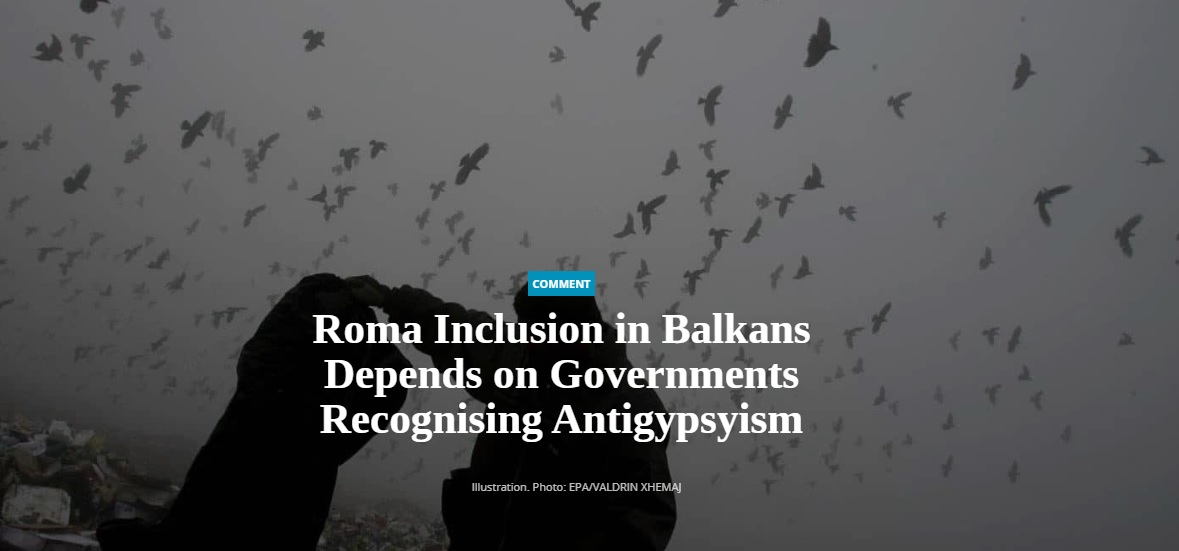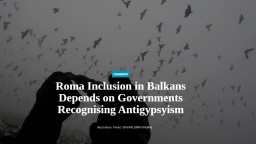
Roma Inclusion in Balkans Depends on Governments Recognising Antigypsyism
Their failure to recognise and combat antigypsyism has also contributed to the limited impact of their strategies and action plans for inclusion of Roma.
The European Union, however, has proposed a concept of antigypsyism, and combatting it will play an important role in the new “Framework for Roma Inclusion” it is due to adopt in 2020.
Roma civil society groups are meanwhile calling on governments in the Western Balkans to recognise antigypsyism, and the need to combat it.
All countries in the Western Balkans with the exception of Kosovo have to develop new strategies and action plans on Roma inclusion in the course of 2020.
This would provide an excellent opportunity for governments in the region to rectify previous and current shortcomings, and improve and institutionalise the fight against antigypsyism.
Powerful prejudices and stereotypes
Surveys like the annual Balkan Barometer demonstrate the scale of rejection of Roma by mainstream society and how deeply rooted anti-gypsyism still is.
In the 2019 barometer, 68 per cent of all respondents in the Western Balkans said they would feel uncomfortable marrying somebody from the Roma community, or if their child had a Roma spouse. This feeling of rejection was strongest in Kosovo, where 83 per cent said they felt uncomfortable with the idea.
In Bosnia and Herzegovina, 41 per cent said they were open to marrying a Roma spouse and 62 per cent would feel (somewhat) comfortable inviting Roma into their house. In Serbia, this figure was 75 per cent.
Answers to questions about co-existence in schools and in the workplace were especially worrying. They might also help to explain why the approaches taken so far, and all the projects implemented in these sectors, have demonstrated such limited results, and have barely led to any improvement in the rate of Roma labour market participation.
Overall, 22 per cent of respondents said they would be uncomfortable with the idea of their children sharing a classroom with Roma pupils. In North Macedonia, this figure was 31 per cent. In Serbia, on the other hand, 84 per cent were fine seeing their children study alongside Roma.
Looking at the workplace, overall, 22 per cent were unhappy working together with Roma. When asked about buying products from Roma, 31 per cent would not be comfortable buying products from Roma either.
The attitudes shown towards affirmative working measures for Roma in the public sector were also revealing.
The respondents may not have been aware that, in all these countries, authorities are legally obliged to promote the employment of minorities such as Roma in the public sector. Either way, the majority of respondents did not support the idea of affirmative measures for Roma.
Existing policies aren’t up to scratch
Looking at these data, it is indispensable for Roma inclusion policies in these countries to address antigypsyism and its obvious expression, which is discrimination.
Analysis of the current strategies and action plans conducted by Roma civil society organisations in the Western Balkans shows that this is not the case right now.
Fundamental change is needed in the current policy approach to combat racism towards Roma and the discrimination against Roma.
In combination with the results of the Balkan barometer survey, it has been shown that the current approaches taken in education, employment and elsewhere will remain without an impact if racism is not addressed in parallel with them.
But so far Roma inclusion policies in the region don’t refer to anti-gypsyism at all. Where inclusion policies do admit at least the existence of discrimination, they contain considerable flaws.
Most of them either deny systemic discrimination or downplay the responsibility of the authorities to prevent and combat discrimination, or their active role in discrimination against Roma.
Albania’s inclusion policy, for example, only admits the existence of “discriminatory attitudes” or ”discriminative treatment” within majority society, which it says “frequently” or “occasionally” occurs.
But both the existence of systemic and rooted discrimination, and the responsibility of the authorities or state structures for it, is denied.
In Bosnia and Herzegovina, the Roma inclusion policy refers primarily to the country’s obligations arising from international conventions or national legal norms. But it falls short of explicitly admitting the existence of discrimination against Roma in the country.
Equally worrying, in light of the scope of the discrimination that Roma face, is that despite admitting that discrimination exists, countries’ action plans contain only a few measures and activities targeting the prevention or fight against discrimination. And only few of the proposed measures have actually been implemented.
North Macedonia’s strategy, for example, admits that discrimination influences the situation on the labour market – but measures explicitly preventing or combatting discrimination on that market are missing. It attributes discrimination to individual employers – from the private sector – but this is not considered systemic. Within education, the strategy does not raise the issue of discrimination and its consequences on the performance and attainments of pupils in education.
Serbia’s strategy notes a “lack of interest” among employers to employ Roma. But although the strategy clearly states that employers are reluctant to employ Roma, it does not mention discrimination or racism as a possible reason for this – or the need to combat this form of discrimination in employment.
Serbia’s strategy dedicates “Operational Objective 3” to the issue of discrimination: “Ensuring effective and efficient mechanisms for identifying various types of discrimination against members of the Roma community, their prevention and steps to be taken in case of discrimination”.
This objective is to be achieved with 11 measures and their respective activities. However, only one measure was scheduled for implementation under the 2017-18 Action Plan – and Action Plans for 2019 or 2020 were not adopted.
Bosnia’s Action Plans on employment, housing and health do not mention the phenomenon of antigypsyism or even discrimination at all. Consequently, no measures are proposed or implemented in order to combat them.
It is still the fault of the Roma
In some Roma inclusion policies, stereotyped narratives directly or indirectly place responsibility for the current situation in education or on the labour market on the Roma themselves – not on the authorities, employers or the majority society.
North Macedonia’s strategy, for example, doesn’t link the small number of Roma employed in the public sector to discrimination within institutions but to the lack of interest among the Roma themselves. Consequently, its action plan does not contain any measures promoting the employment of Roma in the public sector.
Montenegro’s strategy also passes the buck when it comes to stereotypes and prejudices and discrimination against the culture of Roma and Egyptians. It states that this discrimination is a result of “stereotypes and prejudices that exist in relation to Roma and Egyptians (that are) due to the specifics of their culture”.
Kosovo’s Roma inclusion policy targets increased awareness among stakeholders to support education of members of Roma and Ashkali communities. However, it addresses only Roma and Ashkali communities, not members of the majority community, or school personnel. Thus, the functioning of more inclusive education is held to depend on the Roma and Ashkali themselves.
Few policy goals are actually implemented
In addition to flaws in the design of the policy approach toward discrimination of Roma, analysis has identified disturbing shortcomings in the implementation of measures and activities combatting discrimination.
In Albanian education, not a single proposed activity addresses the possible “discriminatory attitude” of members of the majority population. In employment, according to Albanian government reports for 2018 and 2017, not a single activity was implemented that would directly address identifying, preventing or combatting anti-gypsyism or discrimination.
Bosnia’s action plan on education contained the specific objective, “Prevention of prejudice, stereotype and discrimination by 2020”. However, none of the proposed measures was implemented by 2018.
Montenegro’s strategy has identified discrimination as one of the biggest obstacles to employment for Roma and Egyptians. However, it proposes no actual measures to combat discrimination in the field of employment.
In North Macedonia, neither the education nor the employment action plans contain any explicit reference to discrimination in the objectives or measures; none of the measures directly targets preventing or combatting discrimination.
New approach must complement existing strategies
To conclude, while other measures, such as provision of teaching assistants and scholarships, could contribute to combatting the effects of discrimination or antigypsyism, and although existing overall anti-discrimination laws and policies provide a good basis for combatting discrimination, a new policy approach is needed on Roma inclusion, based on recognising and combatting antigypsyism.
Such a new policy approach should complement current activities that aim to improve the Roma’s socio-economic situation, not replace them, thereby achieving a better impact.
Some governments, as in Bosnia, seem to have understood that recognising and combatting antigypsyism is the precondition for a successful and sustainable inclusion of Roma and are considering addressing antigypsyism in the new strategies and action plans.
A concerted effort for a new policy approach is indispensable. This approach should include a variety of measures, ranging from awareness raising and information measures or trainings promoting the concept of antigypsyism, as well as measures improving the situation of the Roma in the fields of education, employment, housing and health.
The region’s governments as well as the European Union and its Member States should recognise that combatting antigypsyism will not only improve the life of the Roma, but is a prerequisite for the creation of a democratic and inclusive society.
Combatting antigypsyism is, in the end, the litmus test for the democratic maturity of a country and for its respect for human rights.
Stephan Müller works with the Central Council of the German Sinti and Roma (Zentralrat Deutscher Sinti und Roma) on an initiative called “Towards a new policy with Roma in the Western Balkans”, in cooperation with Roma Active Albania (Albania), Otaharin (Bosnia and Herzegovina), Advancing Together (Kosovo), Voice of Roma, Ashkali and Egyptians (Kosovo), Phiren Amenca (Montenegro), Romalitico (North Macedonia), Association of Coordinators for Roma Issues (Serbia) and Forum Roma Srbije (Serbia). The initiative is supported by the German Foreign Office.
The opinions expressed are those of the authors and do not necessarily reflect the views of BIRN.
